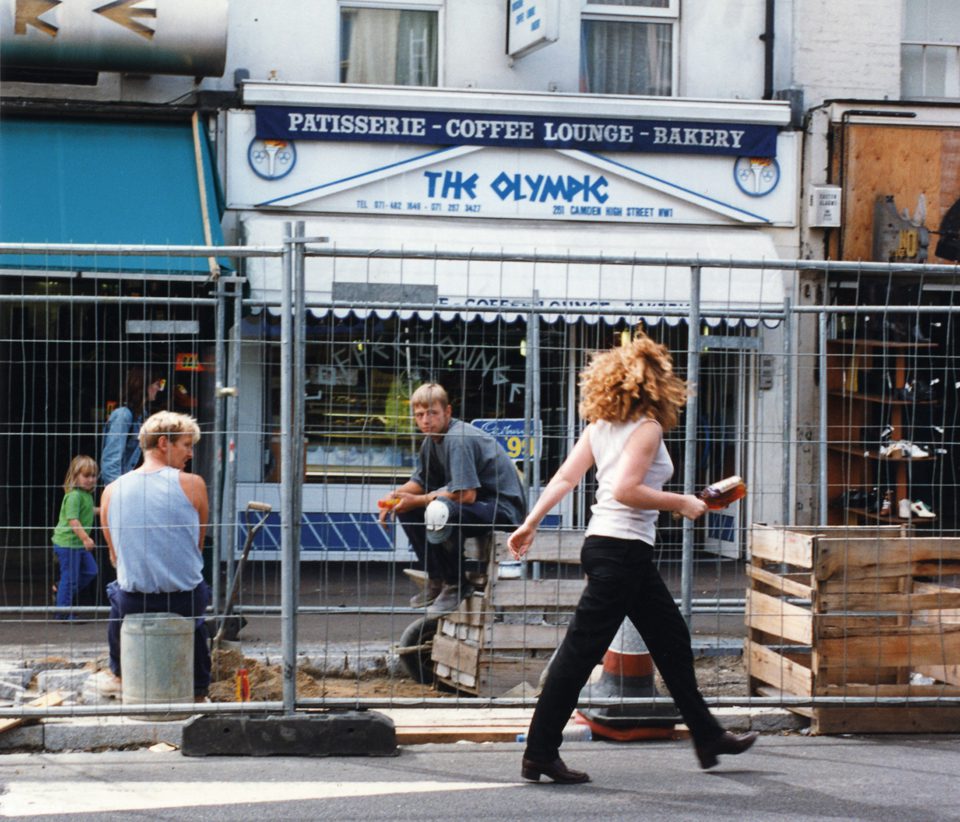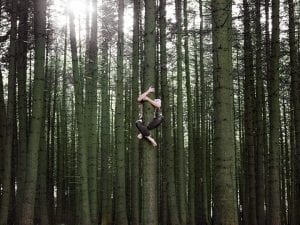A new exhibition of colour photography by Dorothy Bohm at The Museum of London celebrates women in the capital city and challenges their representation from the 1990s to the present day.
As the writer Eudora Welty colourfully put it: “A good snapshot stops a moment from running away.” Deceptively simple as this vivid image may be, it in fact sums up one of the most insistent and enduring impulses behind photography: the desire to capture a moment before it disappears. Rephrased by the cultural theorist Susan Sontag, this is the sentiment that “all photographs are momento mori … Precisely by slicing out this moment and freezing it, all photographs testify to time’s relentless melt.” Dorothy Bohm, whose colour photographs of women in London in the 1990s and 2000s are the subject of an exhibition entitled Women in Focus at the Museum of London, perhaps feels this impulse to preserve more keenly than most, having experienced first-hand the trauma, displacement and loss of World War II and Nazism in Germany, which she escaped in 1939.
In over 70 years of photography, Bohm’s career has seen her capture remarkable images of locations and people across the globe. As its title suggests, however, Women in Focus narrows its field to her recent colour photography of women in London, and in so doing it illuminates the richness and variety of this important and neglected aspect of her career, placing it within the context of her wider project of humanist street photography. As curator Charlotte Samuels comments: “While she reflects on issues surrounding gender and the gaze, her photographs are also full of vibrancy and humour, with posed mannequins seeming to mimic some of those who pass by their shop windows, or women unconsciously repeating the same gesture as the image in an advertising poster. These kinds of motifs run through the work and link the images together. Dorothy’s photographs show her enduring interest in people, especially women, from all walks of life and of all ages.”
Bohm came to colour late in her photographic career, having worked exclusively in black and white from the beginning of her work in the 1940s right through to the 1980s. In 1980, she visited the New York studio of the renowned Hungarian-born photographer André Kertész, one of many contacts she made through her capacity as a director of The Photographers’ Gallery. This encounter inspired and encouraged her to begin experimenting with colour in work. This experimentation took the form of a series of Polaroid images initially, but soon spread more widely throughout Bohm’s photography.
The use of colour is often one of the most charismatic and beguiling aspects of these photographs, and it is an area of her work that the Museum of London has chosen to highlight by displaying the images on colourful yellow walls, rather than on the traditional white space of the contemporary art gallery. This innovative staging focuses attention on Bohm’s own deft, and sometimes even painterly, use of colour in the images. For example, in one image, two women sit on a bench outside the imposing, heady, modernist expanse of the Southbank Centre. Above their heads is a familiar monochrome brand, repeated giddily and absurdly three times: “Time Out Time Out Time Out”. The only strong colour in the image is one woman’s peppermint cardigan, an entirely out of place flash of pastel against her concrete surroundings. As the women enjoy what looks to be a bite to eat and a gossip – in other words, some “time out” – what shines through most is their charm and humanity, thrown into stark and compelling relief by the architectural backdrop. A delightful composition, it’s the comparative irregularity of their skirts, a handbag, their human form and their knees crossed jauntily inwards that gives this image its drama, poise and undoubted humour.
A trope that Bohm has returned to regularly in her work is the form of the torn or ripped billboard poster, a potent and poetic metaphor for our fragmented and disorientated 20th century existence. Naturally, many of these posters feature images of women, layered up with other images. These works call to mind the 1960s and 1970s collages of Gwyther Irwin, which were composed, strip by strip, of advertising material, making up highly poetic and soulful abstract images with great richness and depth. A similar process is evident in Bohm’s Torn Poster, Hampstead, London (1990s), which features a multitude of scraps and fragments – the worn remnants of dozens of previous advertising billboards. The top layer of these countless images is a woman with a white mask on, dressed in dazzling red and with her hand draped across the polo neck of a man dressed all in black. The pose is louche but dangerous, and could be advertising anything from perfume to jewellery, fashion or perhaps a film. However, it isn’t the woman who seems to be devouring the man in this image, in spite of the messages that were devised in the boardroom of a 1990s advertising executive. Rather, it’s the encroaching images behind that eat into him, so much so as to obscure one of his eyes.
A couple of layers back, there is a partially visible and huge male head, the same size as the whole of the two figures. While the eyes are covered over, the corner of one eyebrow is discernible and creates a sense of the head gazing towards the couple in the foreground. The female figure is the most intact figure in the image, a feature that is present in many of Bohm’s torn posters. For example, in Torn Poster, Chalk Farm (1997), a woman’s eyes are the only recognisable human feature in a wall of spiky advertising shreds and slivers. Above the woman, a piece of cord or rope looms noose-like. However, there is something indomitable and intangible in the Turpinesque mask of the woman’s eyes, which is accompanied by the ambiguous phrase “AMA Much love.” As art historian, Monica Bohm-Duchen, has written: “Unsurprisingly, many of these posters include images of women, rendered more disturbing by the violence done to them by the tearing of the images that comes with time and vandalism. In many of these photographs, however, the female principle remains dominant, even challenging; though fragmented, the body parts are not overly eroticised and/or depersonalised.”
These layered and fragmented memorials to piled up and ripped up advertising campaigns interrogate photography and the image culture itself as an aggressive act, along the lines of the writings of Susan Sontag when she describes the “mental pollution” of “an aesthetic consumerism to which everyone is now addicted.” However, Bohm’s most complex, playful and memorable images subvert the fatality of Sontag’s claim profoundly. Rather than seeing photography itself as essentially complicit in the onslaught, her thoughtful images resist the process of consumption and repay attention to their depths and multiple levels.
Layering is also at the heart of photographs such as London, 1996. The image features a London street on what looks to be a morning from the orange sorbet glow of sky reflected in the flats above street level. On one side of the photograph, advertising hoardings cover the buildings, plastered with an at least five times life-size black and white image of a woman who looks to be gazing right at the camera. To the left of the poster is a smartly dressed woman who, by her clothes, we can only assume, looks to be on her way to work, while a loosely knit group of other individuals are walking in differing directions to the right of the poster. To the right, there is also a small tunnel, which leads backwards to another street, suffused in pastel coloured light and with a parked mini-van. Already, this image is dense with layers of revealed and concealed space, such as the interiors of the flats, the space behind the hoarding and the tunnel. However, it is in the final act of layering that this image gains its humour and pique. Just in front of the advertising poster’s face is a “No Entry” traffic sign, its bold red standing out against the black and white poster and the building’s moody and smog-stained stone.
For a photographer who has spent so much of her life travelling and taking photographs in diverse locations including the USA, Europe and Asia, Bohm’s photography of her adopted home of London holds a very special and unique place within her work, as Charlotte Samuels comments: “Although she has lived in London for over half a century, she was included in Tate’s Another London (2012), which featured work by international photographers. I think she has an outsider/insider perspective, perhaps because she wasn’t born and brought up in London.”
However, as Samuels points out, for the second half of the 20th century, Bohm has been one of London’s most important photographic chroniclers, rebutting conventional cultural myths consistently in an attempt to capture the reality of the city. For example, in her celebrated photo-book Sixties London (1996), Bohm eschewed the dominant cultural clichés of swinging London in favour of more mundane, prosaic and, ultimately, more “real” photographs of people going about their lives. As Samuels puts it: “Bohm captures not only what changes in the urban environment, but also what is permanent.”
As a photographer of London, Bohm’s subject is not its iconic buildings or vistas but its bars, coffee houses, streets and, above all, its people. Her work lacks the sense of intrusion or voyeurism that can be present in the works of photographers such as Nan Goldin and Diane Arbus, replaced instead by a deep rooted humanism and empathy. In this way, her work bears more similarity with other humanist street photographers such as Robert Doisneau, Henri Cartier-Bresson and Willy Ronis.
In one photograph, a woman and a perhaps slightly reluctant child walk past a wall decorated with brightly coloured dancing figures, almost in the style of a Calder mobile. The woman wears a red head covering, a green skirt and carries a child-size shocking pink jacket. The girl wears a denim dress above a pink t-shirt, and the light is soft. The figures’ movements echo those of the figures on the wall. Shot from behind, the image seems purposefully unobtrusive; a simple observation of colour, light and movement given complexity by its juxtaposition with the representations of human forms in the wall-painting.
Bohm’s ability to take unthreatening and essentially “kind” pictures is one of her most distinguishing characteristics as an artist, and one that Bohm believes is attributable in part to the fact that she is a female photographer: “As a woman photographing women, I hope that I have shown in my pictures that I understand, sympathise and can identify with my subjects. I never want to take hurtful pictures. I have tried to show the contribution women make to the very diverse, exciting, colourful, if sometimes stressful, London life. I was interested to know if, by looking at my images, it was obvious that a woman had taken them. I asked a photo historian, who knew my work very well, this question. He replied that in general he did not think so, but that indeed some of the photographs could only have been taken by a woman. I must add that I have always found it an advantage to be a woman. Women are often seen as less threatening than men, and are probably better at expressing empathy and emotion through intuition.”
In her 1988 book Vision and Difference, the pioneering feminist art historian Griselda Pollock summarised succinctly what was and is perhaps a central tenet of any discussions relating to the feminine in art and art theory: “Femininity is not the natural condition of female persons. It is a historically variable ideological construction of meanings.” She goes on to discuss Baudelaire’s essay Women and Prostitutes as a fictive construction by a male author of female objects within the modern spaces of the urban environment. The project itself of taking snapshots from a process of walking the streets resembles Bohm’s, and her photography of women in London is of course itself, in a sense, a construction. However, through her interrogations of representation and advertising imagery, and her profoundly humanist street photography, Women in Focus unsaddles any one sense of femininity in favour of a richly diverse and multi-cultural series of individual representations of women.
Dorothy Bohm: Women in Focus ran until 17 February 2013 at the Museum of London. www.museumoflondon.org.uk.
Colin Herd




